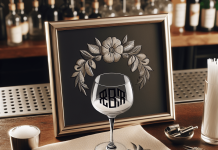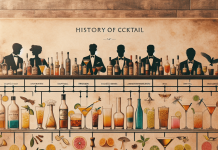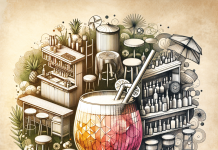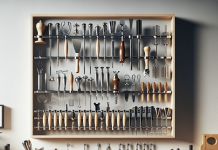In the world of mixology, the sight of bartenders vigorously shaking a cocktail shaker has become an iconic symbol. Have you ever wondered why they do it? Well, it turns out that there’s science behind this rhythmic motion. The shaking action is not just for show, but it actually serves a purpose in creating the perfect cocktail. So, let’s uncover the mystery and find out why bartenders shake up and down.
Overview of bartending techniques
Bartending is an art form that requires a combination of skill, precision, and creativity. At the heart of this craft are various bartending techniques that play a crucial role in creating perfectly balanced and delicious cocktails. In this article, we will explore the different types of bartending techniques, with a particular focus on the shaking technique. We will also delve into the importance of technique in cocktail making and the overall impact it has on the drinking experience.
Different types of bartending techniques
Bartending techniques encompass a wide range of methods that bartenders employ to craft exceptional cocktails. From shaking and stirring to muddling and garnishing, each technique adds its unique flavor to the final product. While some techniques are widely known and used, others are more specialized and require a higher level of expertise. The key is to understand the purpose behind each technique and how it enhances the taste, texture, and presentation of the cocktail.
The importance of technique in cocktail making
Technique plays a vital role in cocktail making, elevating a simple combination of ingredients into a transcendent drinking experience. It goes beyond simply mixing liquids together; it involves a deep understanding of balance, flavor profiles, and the art of presentation. The right technique can transform a mediocre cocktail into a masterpiece, captivating both the taste buds and the eyes. As bartenders, our goal is to create not only delicious drinks but also memorable moments for our customers. Mastering techniques is the foundation upon which we build our artistry.
Shaking as a common bartending technique
When it comes to bartending techniques, shaking is one of the most iconic and widely recognized. It involves vigorously mixing the ingredients of a cocktail in a shaker, creating a harmonious blend of flavors and a desirable texture. Shaking not only combines the ingredients but also aerates and cools them, enhancing both the taste and presentation of the drink. Let’s dive deeper into the mechanics, benefits, and historical context of shaking cocktails.
Explanation of shaking as a technique
Shaking is a technique that involves combining the ingredients of a cocktail in a shaker, then vigorously shaking them to achieve a mixed, chilled, and aerated result. By agitating the ingredients, the flavors are melded together, ensuring a more balanced and cohesive taste. The shaking motion also imparts a frothy texture to the drink, adding an element of visual appeal and enhancing the overall drinking experience.
Benefits of shaking cocktails
Shaking cocktails offers numerous benefits that contribute to the overall quality of the drink. Firstly, shaking helps ensure that all the ingredients are thoroughly mixed together, allowing the flavors to blend harmoniously. It also introduces air into the mixture, creating aeration that enhances the aromas and intensifies the flavors of the ingredients. Additionally, shaking cools the cocktail rapidly, diluting it slightly and providing a refreshing and chilled experience for the drinker.
Historical context of shaking cocktails
The technique of shaking cocktails has a rich historical context that dates back to the early days of bartending. It is believed that shaking was initially introduced as a means to chill and dilute cocktails before the advent of modern refrigeration techniques. In those times, ice was a precious commodity, and shaking provided a quick and effective method of cooling the drink. As the popularity of cocktails grew, shaking became synonymous with the vibrant cocktail culture, and bartenders perfected the art of shaking to create innovative and delightful concoctions.
Proper shaker equipment and tools
To achieve the perfect shake, it is essential to have the right equipment and tools at your disposal. A bartending arsenal is not complete without a well-designed cocktail shaker set consisting of different components that work together seamlessly. Let’s explore the various types of cocktail shakers, the components of a shaker set, and how to select the right shaker for different types of cocktails.
Types of cocktail shakers
Cocktail shakers come in different shapes and sizes, each serving a specific purpose and offering a unique shaking experience. The most common types include the Boston shaker, the Cobbler shaker, and the French shaker. The Boston shaker consists of a mixing glass and a metal tin, which fit snugly together. The Cobbler shaker features a metal tin, a built-in strainer, and a smaller cap that covers the strainer. The French shaker, on the other hand, is a two-piece shaker consisting of a metal tin and a metal cap.
Components of a shaker set
A complete shaker set usually includes several essential components to facilitate the shaking process effectively. These include the shaker tin or glass, a strainer, a jigger for measuring ingredients, a muddler for crushing herbs or fruits, and a barspoon for stirring and layering. Each component plays a vital role in achieving the desired texture, flavor, and presentation of the cocktail.
Selecting the right shaker for different cocktails
Different cocktails may require different types of shakers to achieve the desired results. The choice of shaker depends on factors such as the ingredients being used, the volume of the cocktail, and personal preference. For example, if you’re working with delicate ingredients that require gentle mixing, a Boston shaker with a glass mixing tin may be more suitable. On the other hand, if speed and efficiency are of utmost importance, a Cobbler shaker with its all-in-one design and built-in strainer may be the preferred choice.
Understanding the shaking motion
While having the right equipment is crucial, the technique of shaking is equally important in achieving the perfect cocktail. Understanding the shaking motion and the nuances within it can significantly impact the end result. Let’s explore the difference between shaking motion: up and down vs. side to side and the role of wrist action in shaking.
Shaking technique: up and down vs. side to side
When it comes to shaking, bartenders generally employ two primary shaking techniques: shaking up and down or shaking side to side. Shaking up and down involves a vigorous vertical motion, with the shaker moving in an up and down rhythm. On the other hand, shaking side to side involves a horizontal motion, where the shaker is moved across the body. Both techniques effectively mix the ingredients, but they can produce slightly different results in terms of texture and aeration.
The role of wrist action in shaking
In addition to the shaking motion, the wrist plays a crucial role in achieving the desired outcome. The wrist action can control the intensity and speed of the shake and contribute to the overall texture and presentation of the cocktail. A gentle and controlled wrist action is generally preferred for delicate cocktails that require minimal aeration, while a more vigorous and dynamic action may be suitable for cocktails that benefit from a frothy texture.
Impact of shaking on drink consistency
The shaking technique has a significant impact on the consistency of the drink. The vigorous motion and the introduction of air during shaking create aeration, resulting in a lighter and frothier texture. This texture adds depth and complexity to the drink, enhancing the overall mouthfeel and making it more enjoyable to consume. The consistent agitation also ensures that the ingredients are thoroughly mixed, preventing any separation or uneven distribution of flavors.
Aerating and chilling the ingredients
Aeration and chilling are two crucial aspects of cocktail making that shaking excels at. Let’s explore why shaking helps aerate cocktails, the effects of aeration on flavors, and how shaking contributes to chilling the ingredients.
Why shaking helps aerate cocktails
Shaking cocktails introduces air into the mixture, resulting in aeration that enhances the overall taste and aroma of the drink. This aeration process allows the flavors to meld together, creating a more harmonious and well-balanced cocktail. It helps to unlock the full potential of each ingredient and allows the drinker to experience the complexity and nuance of the flavors in every sip.
Effects of aeration on flavors
The introduction of air through shaking has a transformative effect on the flavors of a cocktail. It can help mellow out harsh or overpowering flavors, making them more palatable. Aeration also intensifies the aromas, allowing the drinker to fully appreciate the fragrance and inviting nature of the cocktail. The combination of flavors and aromas resulting from aeration adds depth and complexity to the overall drinking experience.
Chilling cocktails through the shaking process
Besides aeration, shaking plays a crucial role in chilling the ingredients of a cocktail. As the shaker is vigorously shaken, the ice cubes inside come into contact with the cocktail, rapidly reducing its temperature. This swift cooling not only ensures that the drink is served at an optimal temperature but also adds a refreshing and invigorating element to the overall experience. The coldness of the cocktail is particularly appealing in warm climates and helps to mitigate any overpowering flavors that may arise due to the use of strong spirits or ingredients.
Infusing flavors and achieving balance
The shaking technique not only blends the ingredients but also allows for the infusion of flavors and the achieving of a perfect balance. Let’s explore how shaking enables the blending of ingredients, marries flavors for a harmonious taste, and facilitates the creation of a balanced cocktail.
Blending ingredients through shaking
Shaking is instrumental in effectively blending the ingredients of a cocktail, ensuring that each component contributes to the overall taste. The vigorous motion of shaking allows for the ingredients to interact with one another, creating a cohesive and unified flavor profile. This blending process ensures that no single ingredient dominates the drink, and each element harmoniously contributes to the overall enjoyment of the cocktail.
Marrying flavors for a harmonious taste
In addition to blending, shaking also facilitates the marriage of flavors, ensuring that the various elements of the cocktail work together seamlessly. Through shaking, the flavors intermingle and evolve into a harmonious taste that is greater than the sum of its parts. This marrying of flavors is crucial in creating a balanced and well-rounded cocktail that tantalizes the taste buds and leaves a lasting impression.
Creating a balanced cocktail using shaking
Achieving balance is a fundamental aspect of cocktail making, and shaking plays a pivotal role in this process. By thoroughly combining the ingredients and infusing the flavors, shaking allows the bartender to fine-tune the cocktail’s taste and achieve the perfect balance. The technique enables the bartender to adjust the sweetness, acidity, and potency of the drink, ensuring that no single element overwhelms the others. The result is a cocktail that is not only delicious but also well-balanced and enjoyable to drink.
Adding texture and presentation
In addition to blending flavors and achieving balance, shaking also adds texture to cocktails and enhances the overall presentation. Let’s explore how shaking creates a frothy texture, how visually appealing elements can be incorporated, and how all these factors contribute to the overall drinking experience.
How shaking creates a frothy texture
One of the hallmark characteristics of a shaken cocktail is its frothy texture. During the shaking process, tiny air bubbles are introduced into the mixture, giving the drink a velvety and effervescent quality. The frothiness not only adds visual appeal but also alters the mouthfeel, creating a more luxurious and pleasurable drinking experience. The creamy texture that results from shaking elevates the cocktail and adds another layer of complexity to its overall composition.
Incorporating visually appealing elements
Cocktails are not just about taste but also about aesthetics. Shaking offers the opportunity to incorporate visually appealing elements into the drink, captivating both the eyes and the taste buds. From vibrant garnishes and beautiful glassware to elaborate pouring techniques, bartenders can utilize shaking as a tool to create stunning and Instagram-worthy cocktails. The presentation of a cocktail can enhance the overall experience, making it more memorable and enticing for the drinker.
Enhancing the overall drinking experience
Ultimately, the purpose of shaking is to enhance the overall drinking experience. The combination of textures, flavors, and visual appeal creates a multisensory journey for the drinker, making each sip a moment to savor. By carefully crafting cocktails through shaking, bartenders elevate the act of drinking from a simple pleasure to a memorable and immersive experience. The careful attention to detail and the commitment to technique ensure that each cocktail is expertly crafted and holds the power to delight and surprise.
Shaking vs. stirring
While shaking is a widely accepted and celebrated bartending technique, it is important to recognize that it is not the only method available. Stirring is another traditional technique that has its own merits and applications. Let’s contrast shaking and stirring techniques, discuss when to choose shaking over stirring, and explore cocktail recipes that specifically require shaking.
Contrasting shaking and stirring techniques
Shaking and stirring differ in their approach and the resulting effect on the cocktail. Shaking, as we have discussed, involves vigorous motion, aeration, and the introduction of air bubbles. This technique is best suited for cocktails that contain juices, cream, egg whites, or other ingredients that benefit from thorough mixing and aeration. On the other hand, stirring is a more gentle technique that involves stirring the ingredients with a barspoon in a mixing glass or shaker. Stirring is ideal for cocktails that consist mainly of spirits and require a smooth, silky texture without the added aeration.
When to choose shaking over stirring
Choosing between shaking and stirring depends on the specific cocktail being prepared and the desired outcome. Generally, cocktails that contain acidic ingredients, fruits, or emulsifiers benefit from shaking, as the vigorous motion helps to meld the flavors and create a frothy texture. Shaking is also preferred for cocktails that require rapid chilling or aeration. On the other hand, cocktails with a focus on the purity and clarity of the spirits often call for stirring, as it gently integrates the ingredients while preserving the drink’s clarity and texture.
Cocktail recipes that specifically require shaking
Some cocktails specifically require shaking to achieve the intended taste, texture, and presentation. Classic cocktails such as the Margarita, Daiquiri, and Cosmopolitan all rely on shaking to combine the ingredients and create a frothy texture. Tiki cocktails, with their complex flavor profiles and tropical ingredients, also often necessitate shaking to incorporate and harmonize the myriad components. For those looking to explore the world of cocktails, these recipes serve as excellent starting points to master the art of shaking.
The art of showmanship
While technique undoubtedly plays a significant role in bartending, it is also an opportunity for bartenders to showcase their showmanship and entertain customers. Shaking, in particular, lends itself to a captivating visual spectacle that adds excitement and intrigue to the bar experience. Let’s explore how shaking can be utilized as a captivating visual spectacle, how flair bartending can entertain customers, and how these elements together create a memorable bar experience.
Shaking as a captivating visual spectacle
The act of shaking is inherently captivating, with its vigorous motion and the mixture of ingredients coming together in perfect harmony. Bartenders who have honed their shaking technique can mesmerize onlookers, creating an exciting visual spectacle that adds an element of theater to the bar. As the shaker gracefully moves through the air, the ingredients within swirl and mix, enticing the senses and setting the stage for an extraordinary drinking experience.
Entertaining customers with flair bartending
Shaking provides an opportunity for bartenders to showcase their flair bartending skills, captivating customers with jaw-dropping tricks and acrobatic movements. Flair bartending takes the art of bartending to new heights, incorporating tricks such as bottle flipping, juggling, and intricate pouring techniques. These dazzling displays of skill not only entertain customers but also create a lively and vibrant atmosphere in the bar. The combination of the auditory experience of the shaking sound, the visual spectacle, and the taste of the well-crafted cocktail leaves a lasting impression on patrons, ensuring they return for more.
Creating a memorable bar experience
By incorporating shaking and flair bartending into the bar experience, bartenders create an environment that goes beyond just serving drinks. The combination of skilled technique, visual appeal, and entertainment transforms a visit to the bar into a memorable event. Customers can witness the artistry and expertise of the bartenders firsthand, immersing themselves in an unforgettable experience that leaves a lasting impression. Shaking is not merely a bartending technique; it is a cornerstone of creating an exceptional bar experience that customers will cherish and recall fondly.
Conclusion
In the world of bartending, technique reigns supreme, and shaking stands tall as one of the most iconic and essential techniques. From the blending of flavors and infusing of ingredients to the addition of texture and aeration, shaking plays an integral role in the creation of exceptional cocktails. As bartenders, we understand and appreciate the significance of shaking in our craft, as it allows us to deliver impeccable drinks to our customers. It showcases our skill, expertise, and commitment to the art of bartending, ensuring that each cocktail is an unforgettable experience. So the next time you see a bartender shaking a cocktail behind a beautifully crafted bar, take a moment to appreciate the technique, showmanship, and the dedication it takes to create the perfect drink. Cheers to the artistry of shaking!








































